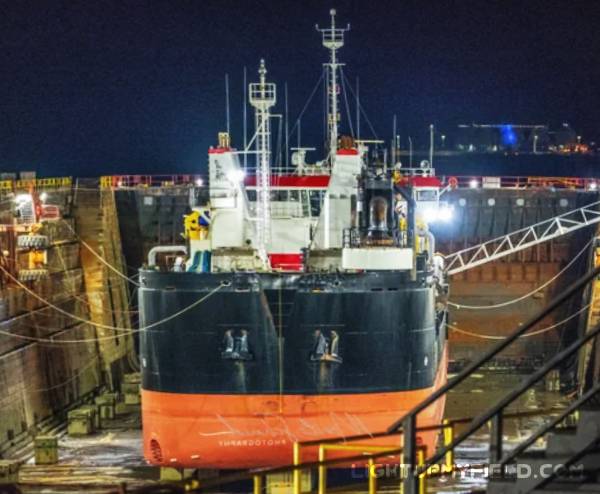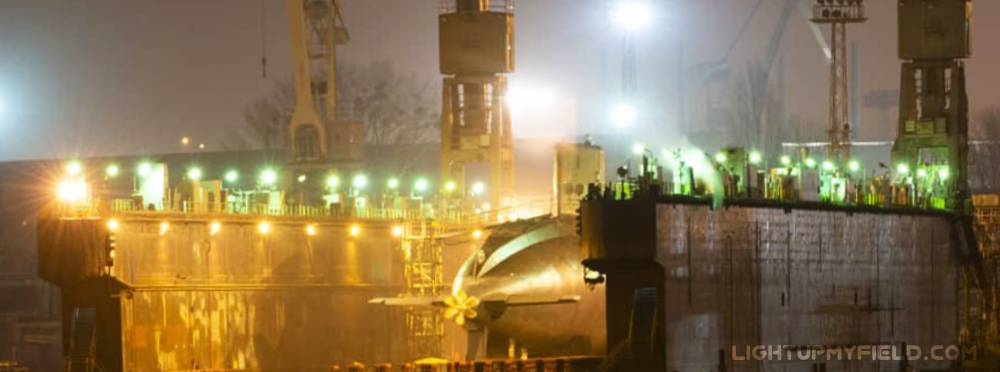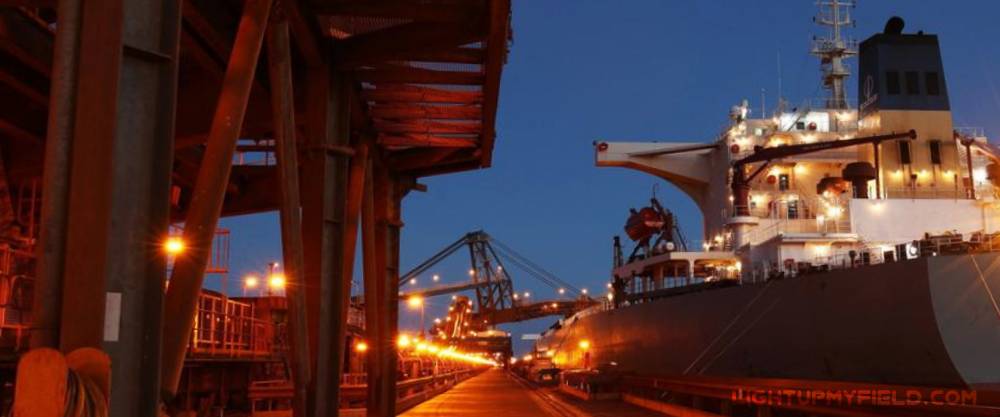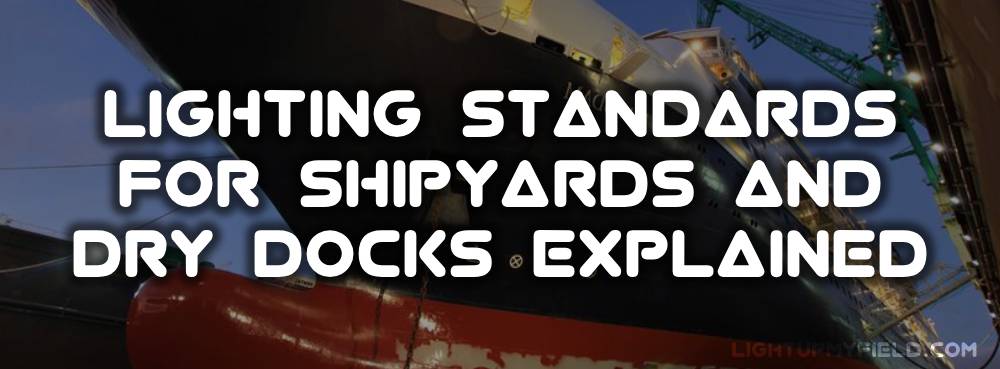When it comes to working in shipyards and dry docks, lighting isn’t just about being able to see what you’re doing—it’s also about safety, efficiency, and getting the job done right. These are massive spaces with towering cranes, machinery, narrow catwalks, and lots of metal surfaces. The lighting has to keep up with the scale and complexity of the work.
So what kind of lighting do these environments actually need? Who decides what’s enough? And how can shipyards make sure they’re meeting the proper guidelines without overcomplicating everything?
Let’s walk through it.
Table of Contents
ToggleWhat Do OSHA, IMO, and IEC Say About Lighting?
When we talk about lighting regulations for shipyards and dry docks, three major names keep popping up: OSHA (Occupational Safety and Health Administration), IMO (International Maritime Organization), and the IEC (International Electrotechnical Commission). These organizations all care about the same thing—safety and visibility—but they approach it from slightly different angles. Some focus more on workplace safety, while others dive deep into the technical design side of things.
OSHA – The Safety Gatekeeper
 OSHA is the big one in the United States when it comes to workplace safety standards. It sets clear minimum lighting requirements for different work areas to make sure workers can actually see what they’re doing and avoid accidents.
OSHA is the big one in the United States when it comes to workplace safety standards. It sets clear minimum lighting requirements for different work areas to make sure workers can actually see what they’re doing and avoid accidents.
For general shipyard areas, OSHA requires at least 5 foot-candles of illumination, which works out to roughly 54 lux. That might sound pretty dim, but it’s the baseline they set for large open spaces where heavy equipment and vehicles move around. For areas where more precision is needed—think welding, cutting, or any detailed repair work—the requirement jumps to 30 foot-candles, or about 323 lux.
To put that in perspective, a typical office usually has around 300 to 500 lux, so for shipyard fine work areas, you’re basically aiming for office-level brightness. And honestly, many shipyards go brighter than these numbers because poor lighting can slow everything down and create hazards.
If you’re below these numbers, it’s not just a comfort issue—you could face compliance problems and higher accident risks. According to OSHA data, poor visibility is a factor in a significant number of workplace injuries every year.
IMO – Safety at Sea and in Dry Dock
The IMO is more global in nature, and its guidelines lean toward safety on board vessels, especially when it comes to navigation, escape routes, and emergency lighting. But their standards matter in dry docks too, particularly during construction or major retrofits when ship systems are being installed or tested.
IMO focuses on making sure visual task performance stays reliable under all conditions, including power failures. They have minimum lux requirements for escape routes—usually at least 10 lux for emergency lighting in corridors and stairways—and insist that backup systems kick in within seconds if the main lights fail.
One interesting detail? IMO also looks at things like glare control and shadow reduction because on a ship (or in a dry dock), harsh contrasts can cause workers to miss hazards or misjudge distances. That’s the kind of stuff that can lead to slips, trips, or worse when you’re working near open hatches or heavy machinery.
IEC – The Engineering Side of Lighting
Then there’s the IEC, which brings the technical muscle. They publish standards like IEC 60092-306, which lays out requirements for lighting design and installation on ships and in marine environments. This goes beyond just brightness—it covers color temperature, uniformity, ingress protection, and resistance to things like saltwater corrosion.
IEC pays special attention to uniform lighting distribution because uneven light can create dangerous blind spots. They also recommend using fixtures rated IP65 or higher for outdoor and wet areas, which means the lights can withstand dust and jets of water. That’s pretty much non-negotiable in a shipyard where spray, rain, and humidity are constant factors.
Color temperature also comes into play here. IEC generally suggests cooler light—something in the 4000K to 6500K range—because it improves visibility and contrast in industrial environments.
Why Do You Need All Three?

Here’s the catch: most shipyards and dry docks can’t just pick one standard and call it a day. OSHA rules are law in the U.S., IMO standards apply if you’re doing anything with vessels, and IEC guidelines are often used as best practice worldwide for engineering and design.
If you’re building new ships, you’ll likely need to consider IMO and IEC on top of OSHA. If you’re doing electrical work or installing lighting systems, IEC is your go-to. And if your shipyard is in the U.S., OSHA compliance is a must.
| Organization | Requirement Type | Illuminance Level | Notes |
|---|---|---|---|
| OSHA | General shipyard areas | 5 foot-candles (≈ 54 lux) | Baseline for open spaces with heavy equipment |
| OSHA | Precision work areas | 30 foot-candles (≈ 323 lux) | Welding, cutting, detailed repair |
| IMO | Emergency escape routes | 10 lux | Corridors and stairways; backup lighting must activate fast |
| IEC | Color temperature | 4000K–6500K | Cooler light for better contrast and reduced eye strain |
| IEC | Fixture protection | IP65 or higher | For outdoor/wet environments; resistant to dust and water |
| IEC | Uniformity & glare control | Not numeric (design focus) | Even light distribution to prevent shadows and harsh contrasts |
Why Color Temperature Matters More Than You Think
Ever walked into a space and thought, “Why does everything look weird?” That’s color temperature messing with you.
Color temperature, measured in Kelvin (K), determines whether light looks warm and yellowish or cool and bluish. Warm light (around 2700K) feels cozy—great for your living room, but not so great when you’re trying to spot a hairline crack in a steel plate.
For shipyards and dry docks, cooler light is the winner. Something in the 4000K to 6500K range works best because it improves contrast, sharpens details, and reduces eye strain. It’s basically like working in natural daylight, which helps you see weld lines, bolts, and tools more clearly.
Using warm light here isn’t just inconvenient—it could actually slow people down and increase the chances of mistakes. You don’t want that when precision and safety are on the line.
Lighting Uniformity and Why Uneven Light Is a Problem
Now let’s talk about something that doesn’t get as much attention as brightness: uniformity. Ever tried working on a bench where one side is bright as day and the other side is gloomy? That constant adjustment your eyes have to make? Yeah, it’s tiring—and dangerous.
Uniformity is about spreading light evenly so you don’t get harsh shadows or sudden glare spots. Technically, it’s measured as a ratio between the minimum and average illuminance, and the closer it is to 1, the better.
Poor uniformity can lead to visual illusions—surfaces might look warped or tools harder to locate. In shipyards, where heavy lifting and precision go hand-in-hand, that’s not a risk you want to take. Getting this right usually means planning fixture positions, angles, and spacing very carefully.
Anti-Glare Features – Are They Really Necessary?

Short answer? Yes. Shipyards are full of shiny surfaces—steel plates, water puddles, polished machinery—and glare bouncing off them can make life miserable.
Too much glare doesn’t just feel uncomfortable; it can cause eye strain, headaches, and even temporary blindness if you look at the wrong angle. Anti-glare designs usually involve diffusers, shields, or lens treatments that soften the light and cut reflections.
Sometimes even going for indirect lighting—bouncing light off walls or ceilings instead of blasting it straight onto surfaces—can help a lot. When you’re working with cranes, scaffolding, and open hulls, every little bit of visibility improvement matters.
How Much Light Is Actually Required?
This is one of the first questions everyone asks: “How bright should it be?” And honestly, it’s a great question because the answer isn’t one-size-fits-all—it depends on the type of work and the location.
Lighting levels are usually measured in lux (metric) or foot-candles (imperial). For context, 1 foot-candle equals about 10.76 lux. So when you see these numbers, just know they’re not random—they really make a difference in what people can see and how safely they work.
Open Yard Areas
Large outdoor areas where heavy equipment moves around don’t need to be super bright, but they can’t be too dim either. Most standards call for 20 lux minimum, which is about 2 foot-candles. However, most modern shipyards aim higher—closer to 50 lux (around 5 foot-candles)—because anything less can make it hard to spot trip hazards, tools lying around, or moving cranes in low visibility conditions like fog or nighttime work.
To give you a sense of what 50 lux feels like, it’s about as bright as a dim parking lot at night. Now imagine trying to do precise work under that. Not ideal, right?
Assembly Zones and Mechanical Work Areas
Things get brighter here because tasks involve more detail. 100 to 300 lux (about 9 to 28 foot-candles) is common in these zones. That’s roughly the brightness of a retail store or a well-lit workshop. Why the big range? It depends on whether you’re just bolting parts together or doing more complex mechanical alignments.
Detailed Inspection and Electrical Work
When you’re dealing with fine details—wiring, inspections, weld checks—you need serious illumination. Think 500 lux or more, which is equivalent to about 46 foot-candles. For comparison, a brightly lit office space is around 500 lux, so these areas basically need office-quality lighting, if not higher. Some precision jobs even push beyond 750 lux, especially when safety or compliance checks are involved.
Emergency Egress Lighting
Nobody thinks about emergency lighting until the power goes out—but it matters. The typical standard here is 10 lux (about 1 foot-candle) for exit routes and stairs. That might sound low, but it’s just enough to see clearly and move safely without tripping over obstacles during an outage.
Why Not Just Go Brighter Everywhere?
Here’s the catch: too much light can be just as bad as too little. Overly harsh lighting can cause glare and eye strain, which is exhausting during 10-hour shifts. The sweet spot is bright enough to see clearly without creating discomfort or visual fatigue. Getting this balance right is where smart lighting design comes in.
Tips to Meet Lighting Standards in Your Shipyard
Thinking about upgrading or designing your shipyard lighting so it actually meets the standards—and works well in the real world? It can feel like a big job, but with the right approach, it’s a lot more manageable than you think. Here’s how to make it happen without wasting time or money.
Start with a Real Lighting Assessment
First things first: don’t guess. A lot of shipyards assume their lighting is fine until someone pulls out a lux meter and finds dark spots everywhere. Grab a meter (they’re not expensive) and measure different areas—walkways, assembly zones, welding bays, storage areas—and see where you really stand.
You might be shocked. In fact, most assessments find at least 30–40% of the facility under-lit, especially in older setups with metal halide or fluorescent fixtures. Knowing your baseline is step one because you can’t fix what you don’t measure.
Go LED, and Don’t Look Back
If you’re still running on metal halide or HPS lamps, it’s time for an upgrade. LEDs aren’t just trendy—they’re practical. They use up to 60–70% less energy, last five to ten times longer, and don’t need warm-up time like old-school lamps.
Plus, LEDs give you better color rendering and are easier to control. You can dim them, automate them, and they stay consistent even in cold or wet environments—two things shipyards have plenty of.
Plan Lighting by Task, Not Just Area
This is where a lot of layouts go wrong. A walkway does not need the same brightness as a welding station. If you throw the same light everywhere, you’ll either waste energy or end up with glare problems.
Break your yard into zones based on what people actually do there—storage, heavy assembly, fine electrical work—and match the lux levels to those tasks. For instance, a welding bay should hit 500 lux or more, while open yard areas might only need 50 lux. It’s all about balance.
And if your operations shift around a lot, consider adjustable fixtures or portable towers. Flexibility can save you a ton in the long run.
Smart Controls = Smarter Energy Use
Ever notice lights blazing in an empty section of the yard at 2 a.m.? That’s money burning. Adding motion sensors or smart controls can cut wasted energy by 30% or more, especially in storage areas, corridors, or during downtime.
Some systems even let you schedule brightness changes for day vs. night or adjust for seasonal daylight variations. A little automation goes a long way.
Choose Fixtures That Can Survive Your Environment
Shipyards are brutal on lighting. Salt air, humidity, dust, vibration—if your fixtures aren’t built for it, you’ll be replacing them way too often. Look for IP65-rated housings or higher for outdoor and wet areas, and make sure they’re corrosion-resistant.
Also, think maintenance: use fixtures with easy access for cleaning and servicing. If it takes an hour to replace a driver, your crew will hate you.
Test, Observe, Adjust
Here’s a secret: even the best lighting plan might need tweaks once it’s live. After installation, walk the site at night and during the day. Are there glare issues? Dark corners? Shadows on critical equipment? Sometimes adjusting the angle or swapping a lens makes a world of difference.

